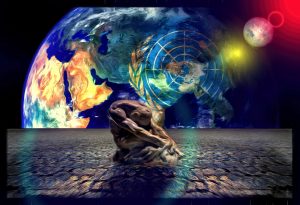1.7: Political Geography
- Page ID
- 73587
Political geography is the study of the spatial distribution of political entities and systems, and the effect that politics has on particular places.
Democracy and Authoritarianism
Democracy is a system of government in which political power is held by the people, who form their government through free elections. Authoritarianism is a system of government in which political power is held by a small minority, often against the will of the people. These are not necessarily two separate categories of government, but two ends of a political spectrum. Some countries, such as Norway, are highly democratic. Other countries, such as North Korea, are highly authoritarian. Many countries, though, fall somewhere in between, with some elements of both democracy and authoritarianism.
A full democracy is a country that regularly holds free, multi-party elections, permits political dissent and a free press, and where the rule of law and individual civil rights are respected. Examples include the countries of the European Union, the United States, Canada, Australia, and Japan. Of course, many of these democracies are not without their flaws. Nearly every democracy has had some experience with corruption involving elected officials, and sometimes free elections are not entirely fair. In the United States, for example, the electoral college, gerrymandering, and the influence of wealthy political donors are often cited as being somewhat undemocratic.
A partial democracy is country with democratic institutions, but which has some undemocratic traits, such as weak opposition parties, rampant corruption, election fraud, significant limitations on free speech and the press, and frequent constitutional changes. Examples include Nigeria, Turkey, Pakistan, and Thailand, which fall on the political spectrum somewhere between democracy and authoritarianism.
Authoritarian governments come in many different forms. Some feature military rule, or rule by a single political party. Others are dictatorships or absolute monarchies, where political power rests with a single individual. Such government do not hold fair elections, have little respect for law or civil liberties, and little tolerance of free speech or a free press. Examples include China, Russia, Algeria, Iran, and Cuba. Many authoritarian countries are nominal democracies, or democracies “in name only.” In fact, all but two of the world’s independent states claim to be democracies, and some of the most authoritarian regimes regularly hold sham elections. It is said that nobody loves elections more than dictators, because the outcome of those elections is predetermined.
Nation and State
Nations and states are the fundamental building blocks of international political geography. These terms can be somewhat confusing for Americans. In the United States, we think of states, such as Illinois, New York, or Oregon, as pieces that make up a whole, which we often refer to as the “nation.” In the context of American politics, this usage is not incorrect. But the terms “nation” and “state” mean something different in the context of world regional geography.
Nation is a cultural term, referring to a large group of people who share a common cultural identity. For example, the Japanese nation consists of all those people who identify as Japanese. State is a political term, referring to an independent government, and the territory it governs. The State of Japan, therefore, refers to the Japanese government and its territory.
Often, nations and states share a geography. A nation-state refers to a state that is dominated by one national group. Examples of nation-states include Armenia, Egypt, and Japan, where more than 99% of the state’s population belong to a single national group. Some nation-states contain significant minority populations, but if one national group is still demographically, culturally, and politically dominant, it is still considered a nation-state. Examples of nation-states with significant minority populations include Turkey, France, and Israel.
A multinational state is state that contains two or more national groups, where no single group is dominant demographically, culturally, and politically. Examples of multinational states include Indonesia, Afghanistan, Nigeria, and Belgium.
There are some countries that fall somewhere between the definition of a nation-state and multinational state. Such evolving nation-states often contain a mixture of indigenous populations and populations of immigrants and their descendants. The United States is an example of such a state. The U.S. could be considered a nation-state, since most people in the country consider their nationality to be “American.” That said, many Americans have a “hyphenated” identity. They are American, but also perhaps African-American, Irish-American, Italian-American, or Chinese-American, to name a few. This ethnic diversity also makes the United States something of a multinational state. Other examples of evolving nation-states include Canada and Brazil.
Finally, there are also stateless nations. A stateless nation is defined as a large group of people who share a common cultural identity, and who occupy their traditional homeland, but who do not enjoy political independence, often finding themselves divided geographically among multiple states. Examples include the Kurds, whose homeland spills across Iraq, Iran, Turkey, and Syria; the Yoruba, whose homeland is found in parts of Nigeria, Benin, and Togo; and the Palestinians, whose homeland is divided among Jordan, Lebanon, Syria, Israel, and the Israeli-occupied territories known as the West Bank and the Gaza Strip.
Autonomy and Sovereignty
The terms autonomy and sovereignty both refer to political independence. If a state is sovereign, that means it has ultimate political authority within its own territory. In sovereign states, there is no higher political power. Autonomy refers to limited independence. An autonomous region is a part of a country that enjoys some political independence at the local level, but which is still subject to a higher political power. Examples of autonomous regions include Scotland in the United Kingdom, the Basque Country in Spain, and Greenland, an autonomous territory of Denmark.
There are some states, known as satellite states or puppet states, that possess nominal sovereignty, but which, in reality, are subject to the political rule of a foreign power. Prominent examples from the past include the Soviet satellite states of eastern Europe. From 1945 until the late 1980s, East Germany, Poland, Czechoslovakia, Hungary, Bulgaria, and Romania were officially sovereign states, but they were, in reality, under the control of the Soviet Union.
Did you know?
There are currently 196 sovereign states in the world. That number includes Taiwan, which is officially part of China, but which has been a de facto sovereign state since 1949, and Kosovo, which has been a sovereign state since 2008, although not all members of the international community recognize its independence.
In Political Geography, the word state, meaning country, can be confusing for Americans who know that their country includes fifty states – meaning fifty political sub-divisions of the United States, a country. Thus, sometimes geographers will use the term State to mean country and the term state to mean political sub-divisions.
Cited and additional bibliography:
Arrhakis, Daniel. 2016. A World Message to the United Nations. https://tinyurl.com/worldmessage2. Attribution-NonCommercial 2.0 Generic (CC BY-NC 2.0).





